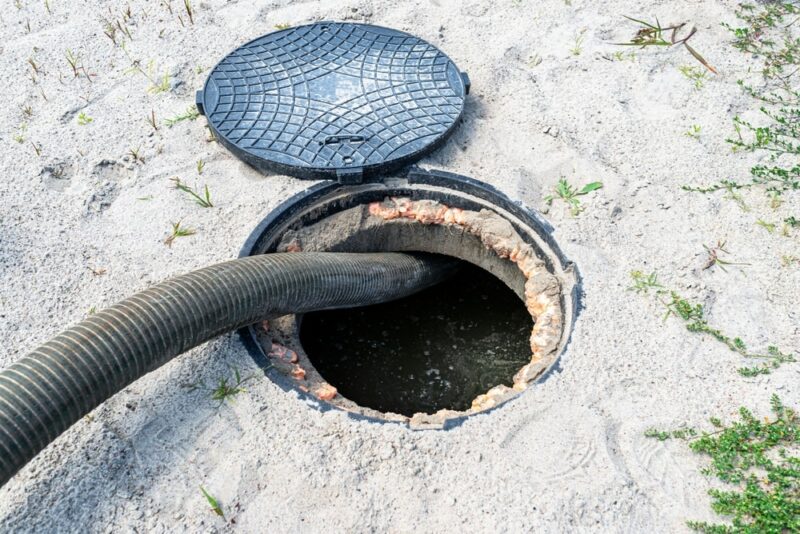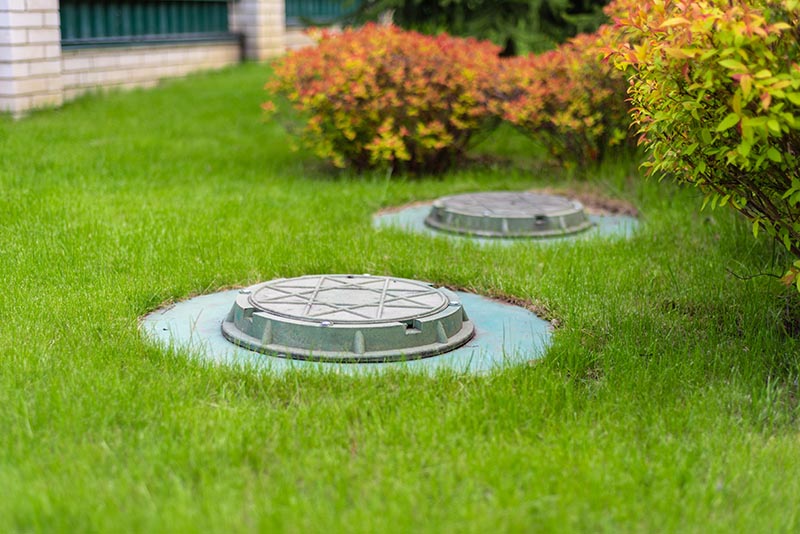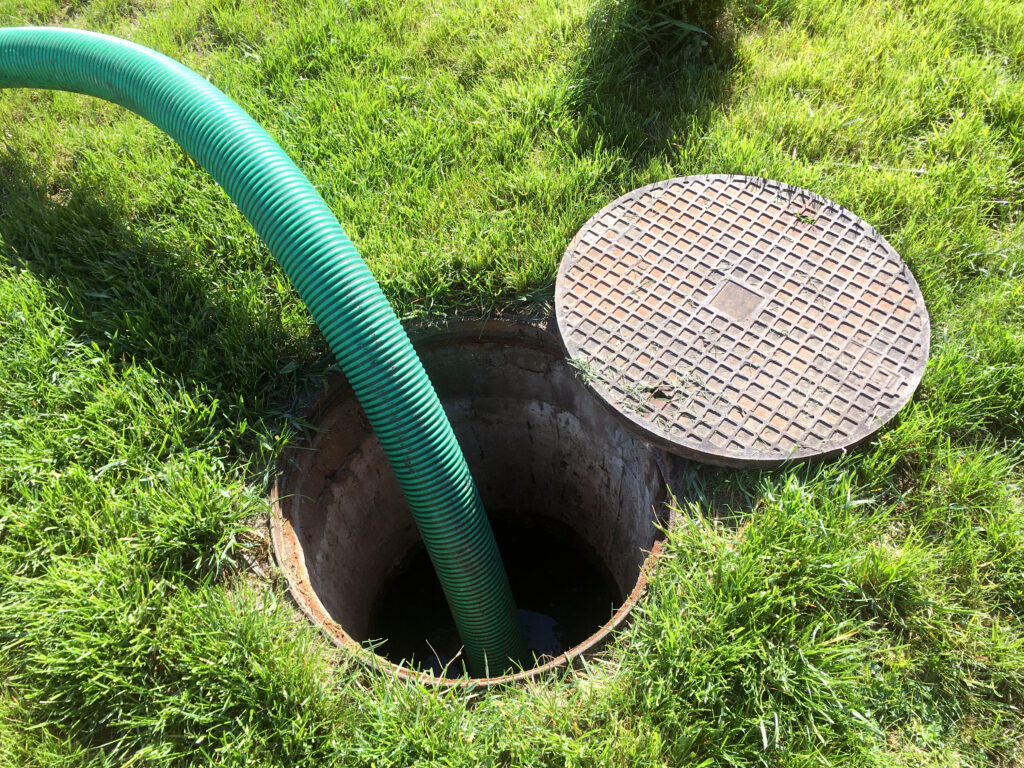What Is a Cesspool: How They Work, Types, Pros & Cons
-
Jeff Weishaupt
- Last updated:

Cesspools and septic tanks are the two most popular options for sewer systems. However, there’s no doubt that cesspools are the more outdated pick, and most of them have been replaced by the more efficient septic tank.
If you’re hoping to replace your cesspool or recognize its failures, it’s crucial you learn how they work first. Essentially, it’s an underground system to dispose of sanitary waste, consisting of a concrete cylinder with perforated sides and an open bottom.
The outdated and unsanitary nature of cesspools makes them a less-preferred system. This article will discuss how these systems work, the different cesspool types, their use cases, and some pros and cons of them.

How Does a Cesspool Work?
A cesspool is best described as a shallow system to dispose of sanitary waste underground. You can find varying structures and types, but most of them are based on a concrete cylinder. It also includes perforated sides and an open bottom.
This system is used to pass sanitary waste from washing machines, sinks, and toilets, percolating out of the cesspool. Unfortunately, cesspools do not treat regular waste and only accept sanitary waste.
The process is simple. First, sanitary waste passes from the home to the cesspool before separating into organic and inorganic solids. The organic solids rise to the top while the inorganic ones sink.
As a result, the naturally occurring bacteria liquefy the organic solids and clarify the liquid before passing it through the perforated sides. This liquid seeps into the surrounding soil, where it remains.

What Are the Different Types of Cesspools?
While large-capacity cesspools are the most common, you’ll also find residential, non-residential, and mixed-use options.
Large Capacity Cesspools
Depending on the state with primary enforcement authority, a large capacity cesspool can mean various things. In some states, “large capacity” refers to the cesspool’s volume capacity. A quick Google search can help you determine whether your state has primary enforcement authority or is regulated by the EPA.
The EPA uses certain measures to identify large-capacity cesspools. For example, multiple regional or community cesspools receiving sanitary waste and containing human excreta with perforated sides and an open bottom are considered large-capacity cesspools.
- Single-family residential cesspools
- Non-residential cesspools receive only sanitary waste with a capacity for less than 20 people a day
- Onsite waste disposal system with a wastewater distribution system, soil absorption area, and buried tank, receiving only sanitary waste
The EPA regulates most of the large-capacity septic systems in the country, and you can visit their website to learn which requirements to meet.
Residential Cesspools
Some large-capacity cesspools serve various residential units, such as apartments or townhouse complexes. In this case, you don’t need to determine the number of daily users or daily wastewater flow to know if they qualify as large-capacity cesspools.
A residential cesspool may be connected solely to a single-family home, receiving only residential sanitary waste. In such cases, it’s considered a small-capacity cesspool that isn’t federally regulated.
Local or state governmental agencies typically control these cesspools, such as the US Department of Health.

Non-Residential Cesspools
The capacity of non-residential cesspools is determined by their construction, design, and the type of infrastructure it serves. These cesspools typically have the capacity to serve 20 or more people every day.
There’s a specific criterion used to determine the potential usage of non-residential cesspools, which is typically done on a case-by-case basis. You may also consider any structural barriers blocking access to the facility or an inaccessible part of private property.
In most cases, you can’t restrict an area to limit the use of a cesspool. If you do plan on restricting an area, you must guarantee that more than 20 people cannot access the cesspool for a given amount of time.
Of course, you must also consider the reasonability of this restriction by countering factors such as the facility’s intended use. Certain measures can temporarily limit the cesspool’s actual use, such as requirements for the public to ask for a key or “Employees Only” signs.
However, these measures aren’t enough to guarantee that over 20 people will not use the non-residential cesspool daily. It’s worth noting that non-residential cesspools serving less than 20 people daily are not regulated by the EPA. However, local or state government agencies may control small-capacity cesspools.
Mixed-Use Cesspools
Certain large-capacity cesspools receive sanitary waste from both residences and businesses. That may include home-based pet grooming services, agricultural operations, yoga studios, auto repair shops, childcare centers, and beauty salons.
In this case, you don’t need to determine the number of daily users or daily wastewater flow to know if they qualify as large-capacity cesspools
Other Cesspools
Any sized cesspools receiving waste from industrial or commercial processes are known as industrial wells. These cesspools do not receive sanitary waste or have the same regulations as a standard large-capacity cesspool.

Where Is It Used?
Cesspools are mainly used to receive and hold sanitary waste, but they can also be used as infiltration systems.
Holding Tank
In the UK, a cesspool or “cesspit” is essentially used to receive and temporarily store sewage. Meanwhile, it’s commonly known as a “holding tank” in North America. It’s crucial for authorities to empty this tank at least every six weeks since it’s sealed.
However, that frequency can vary based on the cesspool since certain options can require cleaning after a week or every month. This frequent emptying and cleaning can make cesspools costly to maintain.
In fact, cesspool owners in the UK can get fined up to £20,000 for failing to maintain their cesspools.
Infiltration Systems
The initial design of a cesspool consisted of a dry well of loose-fitting stones. This version disposed of the sewage by infiltrating it into the soil. The liquids were much easier to infiltrate due to the soil conditions. Meanwhile, solid matter decayed into composted matter onto the cesspool’s base.
The solids accumulate over time. Eventually, they’ll block the liquids from infiltrating, which causes the cesspool to overflow. As a result, a biofilm forges into the loose soil around the cesspool, wearing down the pollutants present.
However, this isn’t effective with deep cesspools, which can enable the raw sewage to enter the groundwater directly. This sewage is not biologically cleansed. This can cause groundwater pollution, which makes water supplies undrinkable.
That is why drilling deep water wells near the cesspool on any property are prohibited. In the US, most residential cesspools are better described as rudimentary septic systems. These systems consist of a concrete-capped pit of masonry units or cinder blocks.
These units are laid sideways while the perforated drain field piping extends below the intake connection level. In most cases, the concrete cap will include a cleaning pipe above the ground. You may also find options that feature concrete walls on the sides.


Advantages of Cesspools
In the modern world, there aren’t many advantages to cesspools since septic tanks are almost always a better option. Still, it’s worth noting that they’re a simple and affordable way to collect human waste. In specific conditions, a cesspool may be better suited than a septic tank.
For example, certain soils aren’t ideal surfaces for drainage, which can make it impossible to install a septic tank on your property. Poor soakaway systems infiltrate the water slowly. But it can also cause issues in high clay-content regions or non-absorbent soils.
Other than that, if you only need a waste-holding system for a short time, it’s better to opt for cesspools, as they’re easy to install and remove. That may include seasonal peaks for campsites or the construction of a building.

Disadvantages of Cesspools
Once you see past the simplicity and affordability of cesspools, there’s no doubt that the system has many flaws and disadvantages. Most importantly, cesspools are costly to maintain since they require frequent emptying.
In fact, the cost of emptying a cesspool via a vacuum truck is higher than most people with average incomes in rural communities can afford. To prevent this, some may build cesspools to infiltrate the leachate into the soil, which can cut down the emptying frequency and costs.
Today, cesspools are better used as overflow pits for septic tanks. This use is more efficient than the traditional system as it doesn’t receive as much solid waste. Without the septic tank, the cesspool will remain difficult and pricey to maintain.
It can also cause the oversaturation of the drainage area near the leaching pool. As a result, it may require professionals to dig more pools to accommodate the volume.
Finally, cesspools are naturally vulnerable to failure. That includes flooding by heavy rains or overflowing since they’re not enclosed like a conventional septic tank system. Tree roots can also enter waste cesspools, causing the system to fail.

Frequently Asked Questions (FAQs)
Did EPA Ban Large-Capacity Cesspools?
Yes, the EPA has banned large-capacity cesspools for various reasons. Most importantly, liquid waste from cesspools can infiltrate into the groundwater. This can make water sources undrinkable.
- Cesspools don’t have the facilities to treat sanitary waste.
- Cesspool waste contains high nitrate and coliform bacteria levels which aren’t allowed in drinking water.
- Cesspool waste may contain chlorides, viruses, cleaning chemicals, grease, phosphates, and other pollutants.
- Regions using cesspools most likely utilize groundwater as a drinking water supply. It can become undrinkable due to infiltrated liquid waste.

What Are the Regulations Regarding Cesspools?
Regulations regarding cesspools vary in the US and the rest of the world. Generally, environmental regulations do not allow the use of cesspools in the modern world. Instead, they encourage septic tanks or connection to local sewer systems.
Most countries prevent homeowners in environmentally sensitive areas from installing septic systems. This occurs due to protective regulations for the watershed. Instead, they’re encouraged to install holding tanks.
In the US, existing residential cesspools are “grandfathered” in most localities. That means they’re allowed to run until they stop functioning, after which they must be removed and replaced with a septic system.
If the area has an abnormally high water level, they’ll need to install an above-ground drainage system for the cesspool. This is also required if the area fails a percolation test. Additionally, local laws vary for the sales of residential properties using an existing cesspool.
In some jurisdictions, they may even ban the sale if a residential property is using a cesspool system. Meanwhile, others use the grandfather clause to permit the sale or transfer of the property.
What Causes Cesspool Failure?
In a failing cesspool, the liquid waste may not soak into the surrounding soil due to the soil conditions. In that case, the sewage re-enters the system, causing either of two unfortunate results.
In one case, the wastewater visibly puddles on the ground, while the sewage may re-enter the home in the worst-case scenario. If you flush the toilet and it gurgles and rejects the water, it’s possible that your cesspool is clogged and unable to accept the waste.
A simple way to notice a clog in the system is by checking if the grass is greener or taller around the cesspool. That’s because the waste may fertilize the soil instead of draining away.
- Extreme water usage
- Age (A cesspool typically lasts 15 to 20 years)
- Abnormally wet weather
- Insufficient cesspool capacity
- Nearby tree roots blocking the system
- Physical damage
- Bad soil conditions
- Vehicles driving over the system

Conclusion
Although cesspools are found all over the US and Europe, they’re best replaced with a more efficient septic tank. Not only do cesspools have endless regulations and health hazards surrounding them, but they’re also hard to maintain.
If you’re looking for replacements, some good alternatives include septic systems, package plants, holding tanks, and sanitary sewer hookups.
Contents
